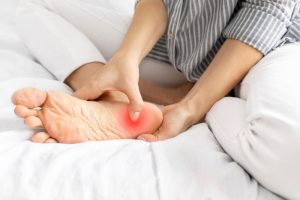
As a healthcare worker, your dedication is to the care and comfort of your patients, but that’s hard to do when you are suffering yourself with plantar fasciitis. Plantar fasciitis, a condition caused by inflammation of the plantar fascia, is one of the most common causes of heel pain. It develops over time, due to overuse, shoe type, foot structure, and unforgiving walking surfaces, and is characterized by shooting or dull pain in the heel, especially after a long day or first thing in the morning. Pain when walking is no fun for anyone – but those in the physically demanding field of medicine, it can be especially debilitating.
So, how can healthcare workers treat plantar fasciitis? Here are five tips to help minimize heel pain and keep yourself healthy… so you can keep delivering top notch care to your own patients.

Rest – Easier said than done in the hospital environment, right? While sitting and resting your feet might not be feasible during your shift, rest is crucial to healing (how many times have you told a patient that?). However, in those times when you do get a break, kicking back and elevating the affected foot can help keep the condition from worsening. When you are on your feet, say entering information at a computer, you can improve your foot and calf strength and mobility through small stretches and movements on each side.
The Right Footwear – Choosing the right shoes and socks for your healthcare work is both a preventative measure and a healing measure for plantar fasciitis. Cushioned shoes that support the arch of the foot are key for protecting the foot (many podiatrists recommend the trendy brands On or HOKA for comfortable, stylish shoes that promote foot health). You can also opt for inserts, like these from Dr. Scholl’s, that have 23,000 reviews at 4.5 stars! You can protect your foot tissues before you even put on shoes, by choosing compression socks that provide arch support and reduce swelling and inflammation. Try this fun pair from SockWell, available on the UHQ website!
Ice – After a long shift, you might look forward to collapsing on the couch with a cup of tea and a few episodes of Bridgerton, but before you settle in, grab an ice pack! Icing helps reduce inflammation, and can help to alleviate pain associated with PF. Massage, either done yourself or with the help of a partner, can also help– just remember not to skip the calves!

Physical Therapy – As previously mentioned, there are a handful of low-impact exercises that, by strengthening and mobilizing the muscles and tissues of your lower leg and foot, can help minimize symptoms and impede further injury. While a few can be done while on the job, some more in-depth moves can be done at home, or under the supervision of a physical therapist.
Steroid Injections – If your pain doesn’t seem to be improving with the help of rest, ice, orthopedic footwear, and physical therapy, it may be time to take more serious action. While they don’t cure plantar fasciitis, corticosteroid injections by a medical professional have been clinically shown to be effective in reducing heel pain in patients suffering from PF. As a healthcare worker with a physically demanding job that allows little rest, this may be the best course of action when other treatments aren’t improving your condition.
Working in medicine means you spend your days caring for the health and comfort of others – but it’s essential you care for yourself too! Without the proper treatment, plantar fasciitis won’t “go away on its own,” and in fact can become a serious case that requires surgery. But by choosing the correct footwear, stretching and exercising, and getting rest, ice, and massage whenever possible – plantar fasciitis is manageable for 95% of sufferers. Treat your feet today– starting with comfortable, quality compression socks from UHQ.


 From Butcher Aprons to Smart Fabrics: The Evolution of Scrubs
From Butcher Aprons to Smart Fabrics: The Evolution of Scrubs 